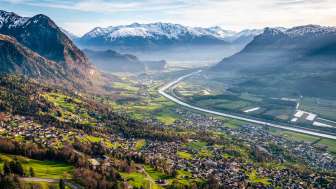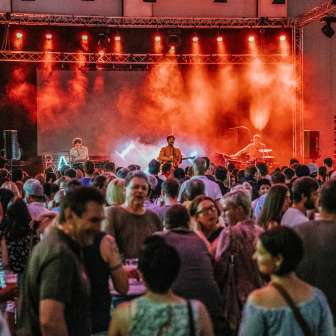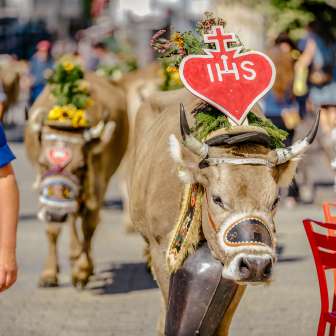Facts & figures about Liechtenstein

At the heart of Europe
The sixth smallest country in the world is located in the center of the European Alpine arc between Switzerland and Austria. Despite its small size, the Principality plays an important role as a business hub, financial center and tourist destination.
- Population: approx. 40,000 (as of 2024)
- Language: The official language is German. However, an Alemannic dialect is spoken.
- Religion: 79% Roman Catholic, 8% Protestant, 13% other
- Land area: 160 km²
- Municipalities: 11
- Main location: Vaduz
- Topography: Lowest point: Ruggell Wetland 430 m a.s.l. Highest elevation: Grauspitz 2599 m a.s.l.
- National border: 76 km (border with Switzerland 41.1 km, border with Austria 34.9 km)
- Largest extension: 24.6 km long and 12.4 km wide
- Form of government: Constitutional hereditary monarchy on a democratic and parliamentary basis
- Head of state: Prince Hans-Adam II. In 2004, Hereditary Prince Alois was appointed deputy to Prince Hans-Adam II.
- Government: Collegial government with five members
- Parliament: 25 members from two constituencies, with a four-year legislative term
- Economy: Liechtenstein is an important financial center and a member of the European Free Trade Association (EFTA). The gross domestic product (GDP) per capita is one of the highest in the world.
- Number of companies: 5508
- Number of employees: approx. 43,000
- Quality of life: Thanks to its high standard of living and stable political situation, Liechtenstein is one of the countries with the best quality of life in Europe.
- More on liechtenstein-business.li
The area of today's Principality has been inhabited since the Neolithic Age.
In 15 BC, it was conquered by the Romans and incorporated into the Roman province of Raetia. After Roman rule, the Rhaeto-Romanic area was germanized under Frankish administration and the immigration of Alemanni. The present-day state was founded by the Princes of Liechtenstein through the purchase of the County of Vaduz (1712) and the Lordship of Schellenberg (1699). In 1719, the two territories were united and elevated to the status of an Imperial Principality. Since then, it has formed a separate state under the rule of the Princely House of Liechtenstein.
Even today, the country consists of two separate political constituencies, the Oberland (highlands, south) and the Unterland (lowlands, north), because of this historical division.
Good to know
Currency
The currency used in Liechtenstein is the Swiss franc (CHF). Euros are accepted in most places.
Time zone
Central European Time (GMT +1 hour), plus daylight saving time (+1 hour) from the last weekend in March to the last weekend in October.
Current voltage
220 Volt alternating current
Plug: Type J sockets are used in Liechtenstein. You can also use devices with a 2-pin Euro plug without an additional adapter.
Climate
In winter, the thermometer rarely drops below -15 degrees Celsius, while in summer the average temperatures fluctuate between 20 and 28 degrees Celsius. Despite its mountainous location, the climate is rather mild and is strongly influenced by the south wind (Föhn).
Telephone
Area code: +423
Tips
Tipping is not obligatory. As a rule, however, they amount to 5-10 percent.
Shopping
General store opening hours:
Monday to Friday: 8:00 am-12:00 pm & 13:30 am-18:30 pm
Saturday: 8:00 am-16:00 pm
Souvenir stores
Open all year round (including Sundays and public holidays).
Popular souvenirs: wine, ceramics, stamps, confectionery, Swarovski crystal figurines, literature about Liechtenstein, watches, jewelry and much more.
Facts about Liechtenstein (2022)
Stay up to date
Our newsletter will keep you informed about exciting events, offers and news.



